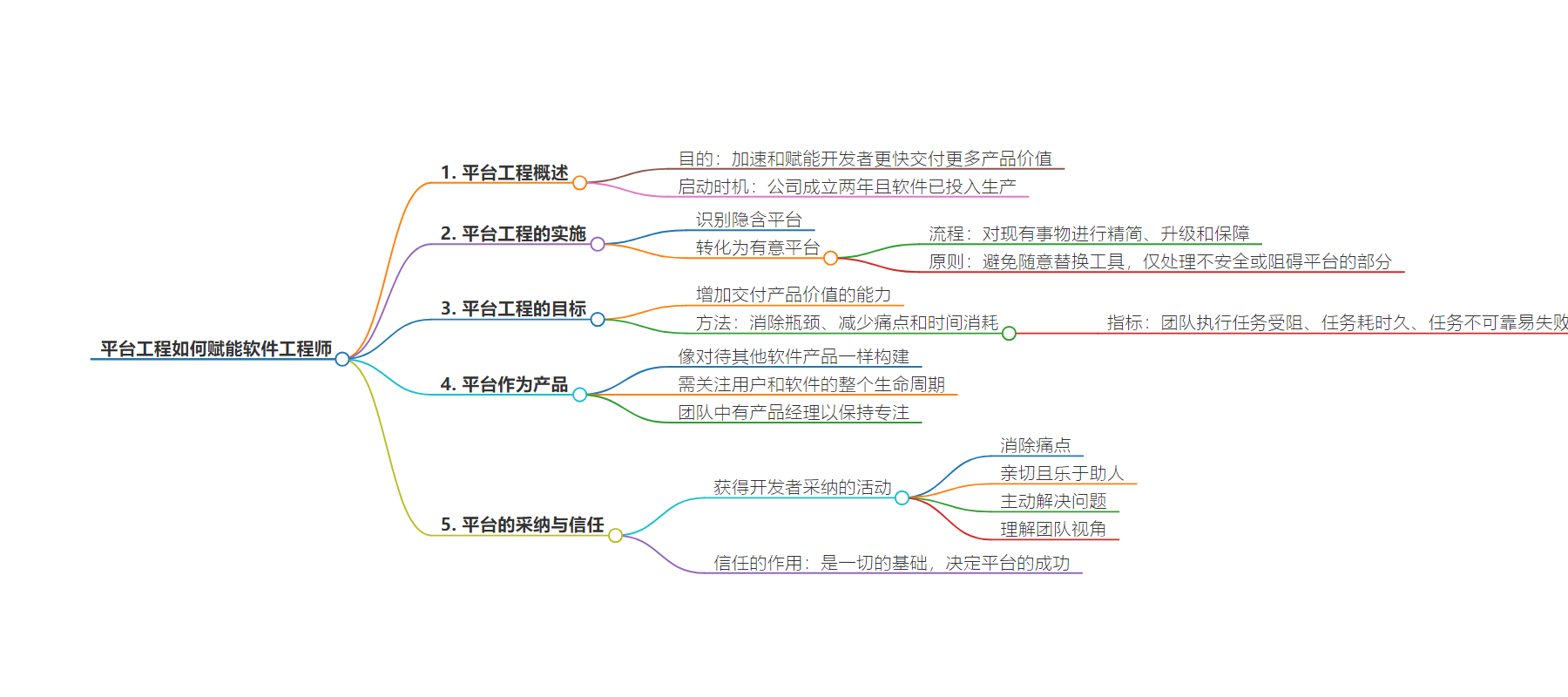包阅导读总结
1. 关键词:平台工程、软件工程师、产品价值、开发者体验、信任
2. 总结:本文探讨了平台工程对软件工程师的赋能,提到公司在特定阶段启动平台工程,将隐式平台转为有意平台,目标是增加产品价值交付能力,要关注用户和解决常见迫切需求,像对待产品一样构建平台,且信任对平台支持很重要。
3. 主要内容:
– 平台工程介绍
– 旨在加速和赋能开发者更快交付更多产品价值
– 多数公司达到一定规模才投资
– 某初创公司实践
– 公司两年且软件已在生产中时启动平台工程团队
– 识别隐式平台并将其转为有意平台,保留部分原有工具
– 平台工程团队目标
– 增加交付产品价值的能力
– 解决团队执行任务中的瓶颈、痛点和耗时问题
– 平台即产品
– 关注用户,与产品经理合作聚焦正确问题
– 平台采纳与信任
– 通过消除痛点等活动建立信任以获采纳
– 信任是平台成功的关键
思维导图:
文章来源:infoq.com
作者:Ben Linders
发布时间:2024/7/11 0:00
语言:英文
总字数:737字
预计阅读时间:3分钟
评分:87分
标签:平台工程,开发者体验,产品管理,软件开发,QCon 伦敦
以下为原文内容
本内容来源于用户推荐转载,旨在分享知识与观点,如有侵权请联系删除 联系邮箱 media@ilingban.com
Platform engineering is about accelerating and empowering developers to deliver more product value faster over time. According to Jessica Andersson, most companies don’t invest in platform engineering until they reach a certain size. At QCon London she presented how their startup adopted platform engineering, what strategy they took, and what they have done to gain platform adoption from developers.
Andersson mentioned that they launched their platform engineering team when the company was two years old and already had software running in production. As soon as you have software in production, you have an implicit platform, regardless if you know it or not, she said. This implicit platform is built in bits and pieces to solve whatever need the teams have at the moment and once it works well enough, whoever built it goes back to building the product, she added.
Starting out with platform engineering they first identified their implicit platform and then started to turn it into an intentional platform:
Basically we took existing things and streamlined, upgraded, and secured them. It’s important here to acknowledge that the implicit platform was built with the best knowledge available at the time and to remember that this was not the main focus for those building it.
It’s important to avoid replacing all tools just because they would not have been your first choice; replace the ones that are insecure or hinder your platform, Andersson said.
The main goal of the platform engineering team is to increase the ability to deliver product value, Andersson said. You can do this through removing bottlenecks and reducing pain points and time sinks:
Some indicators we look for in order to identify where we need to spend more effort are:
- Teams are blocked from performing tasks
- The tasks teams perform take long time
- The tasks teams perform are unreliable and prone to failures
There are always trade offs you need to make; being a small team we definitely can’t take on everything, Andersson said, but we aim to solve the most common and urgent needs.
Treating your platform as a product means building it like you would any other software product. The platform has users, problems that it solves, and a lifespan throughout which you need to take care of both the software and your users, as Andersson explained:
I often see platform teams forgetting about the users when it comes to migrations or switching to new tools, and they deprecate the old thing without providing a seamless transition to the new thing.
Andersson mentioned that you need to keep a focus on what your product is. Working with a product manager in the team is important to maintain that focus:
I try to focus a lot on solving the right problems as well. As a platform engineering team in a cloud native environment there are infinitely interesting problems you can work on; the question is whether you should. So finding out what are the right problems for your organisation and your users is important in order to spend time on those problems.
Platform engineering aims to improve the developer’s experience, Andersson said. Internal developer platforms can help you build a good foundation for good developer experience, helping your teams focus on building excellent products, she concluded.
InfoQ interviewed Jessica Andersson about platform adoption and building trust.
InfoQ: What have you done to gain platform adoption from developers?
Jessica Andersson: Some activities we’ve seen that build trust and thus encourage adoption from our teams are:
- Remove pain points – we show our teams that we care about them and can improve their experience
- Be approachable and helpful – people more likely to reach out to us again, spreading the word to their teammates
- Be proactive – while being approachable we might hear about pain points the teams don’t realise we can solve for them, if we fix it we will gain more trust
- Understand the teams’ perspective – if we understand where they come from, what they know and not, then we can communicate in the same language and better understand their pain points
InfoQ: What role does trust play in supporting a platform?
Andersson: Trust is important as everything builds on it. Adoptions, information, communication: it all comes back to trust.
I believe that as a platform team it’s very important to build a high level of trust with the product teams as it will determine how successful your platform will be.
